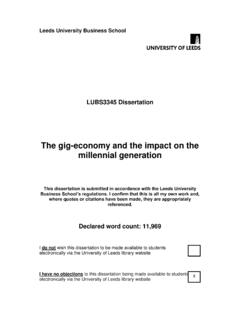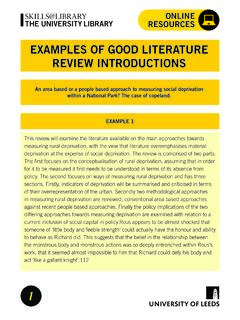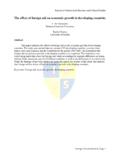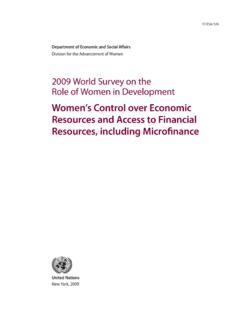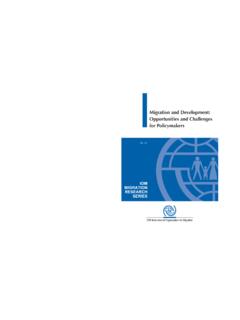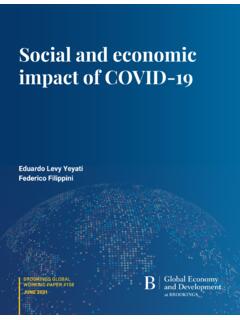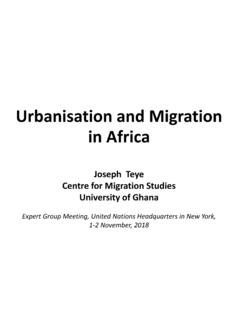Transcription of Sample Dissertation 2 - Quantitative - University of Leeds
1 The impact of FDI and Remittances on economic Growth in South Asia: A Panel Data Study Degree: BSc International Business and Economics Supervisor: Munjal 08 Fall Word Count: 10,000 Contents List of Tables ..ii List of 1. Aims, Research Questions and 2. Literature Foreign Direct International 3. Data and Missing 4. Results and Sri 5. 6. Conclusion and i Acknowledgements First and foremost, I would like to express my sincere gratitude to my supervisor, Dr Surender Munjal, for his continuous support during my Dissertation in terms of his patience, motivation and vast knowledge. I have received great help through his guidance and I could not have asked for a better supervisor for my BSc Dissertation . I would also like to thank my family and friends for always supporting me and believing in me and actually took the time out to read this lengthy Dissertation !
2 Ii List of Tables Table 1: FDI-Related Regulatory Changes, 1991- Table 2: Remittances, FDI and ODA in South Asia, Table 3: GDP in Current US$ in South Asia, Table 4: Variables and their corresponding Table 5: VIF values for original Table 6: Summary Table 7: Assumptions for OLS, GLS and GMM ..29 Table 8: Random-Effects GLS iii List of Figures Figure 1: FDI Inflows to Developing countries and the South Asia share of World FDI, iv Abbreviations The following table describes the various abbreviations and acronyms used throughout this study. The page on which each one is defined or first used is also given. Abbreviation Meaning Page FDI Foreign Direct Investment 1 HCFs Host country factors 13 IMF International Monetary Fund 3 MNEs Multinational Enterprises 1 ODA Official Development Assistance 1 OECD Organisation for economic Co-operation and Development 11 SAARC South Asian Association for Regional Cooperation 5 UNCTAD United Nations Conference on Trade and Development 1 1 1.
3 Introduction This chapter provides the background, justification, aims, research questions and objectives of this study. It also briefly mentions the findings and provides a structure for the Dissertation . Background The three main pillars of growth for developing countries are: foreign direct investment (FDI), official development assistance (ODA) and international remittances (Alfieri and Havinga, 2006). We focus on FDI and international remittances. FDI includes tangible and intangible assets such as money and the transfer of technological capabilities. We define FDI in accordance with the United Nations Conference on Trade and Development (UNCTAD, 2007), who describe it as an investment involving a long-term relationship and reflecting a lasting interest and control by a resident entity in one economy in an enterprise resident in an economy other than that of the foreign direct investor . World FDI inflows have increased greatly, totaling US$ trillion in 2010 compared to US$53 billion in the 1980s (World Bank, 2013).
4 Multinational enterprises (MNEs) are investing in developing countries due to lower production and labour costs and higher profits. Figure 1 illustrates this; developing economies received over US$ 700 billion in 2011 compared to approximately 100 billion in 1996 (ADB, 2006; Sahoo, 2006) and they accounted for more than 60% of global FDI inflows in 2013 (UNCTAD, 2013). Starting from the late 80 s, many developing nations opened up their economies to international trade. Table 1 shows the regulatory changes that occurred between 1991 and 1998; 94% of these changes were favourable to FDI (UNCTAD, 1999). However, South Asia s FDI inflows as a share of world FDI remain one of the lowest compared to 2 other developing regions; it averaged less than 2% between 2000-11. This is shown in Figure 1 where the graph is hardly visible for South Asia (World Bank, 2013). Many developing nations seek FDI due to the potential direct and indirect benefits.
5 Direct advantages include access to modern technology and financial capital. Indirect advantages (spillovers) can be experienced through the mobility of employees from an MNE to local firms who use their expertise gained in the MNE to increase productivity in local firms (Dunning and Lundan, 2008). The host country can also use FDI to improve living conditions, infrastructure and much more. Table 1: FDI-Related Regulatory Changes, 1991-1998 Item 1991 1992 1993 1994 1995 1996 1997 1998 Number of Regulatory regime changes of which: 82 79 102 110 112 114 151 145 More favourable to FDI 80 79 101 108 106 98 135 136 Less favourable to FDI 2 - 1 2 6 16 16 9 Source: UNCTAD (1999) 3 Figure 1: FDI Inflows to Developing countries and the South Asia share of World FDI, 1990-2011 There has been a large increase in migrants people born in low and middle-income countries that reside in high-income nations: 154 million in 1990 to 232 million in 2013 (Connor et al, 2013).
6 Many migrants send money to their home country that is called remittances. We define remittances according to the IMF (2010) (cited in World Bank, 2011 ) whom define it as current private transfers from migrant workers who are considered residents of the host country to recipients in the workers country of origin . Workers are considered residents if they live there for more than a year. Remittances inflows have increased rapidly and in some developing countries they are the largest source of external funding since they are the most stable form of Source: Created by author. Data from: ADB (2006) and Sahoo (2006) 4 finance, unlike ODA, which depends on political imperatives (Premaratne and De Mel, 2009). South Asia is the second largest remittances recipient. India, Bangladesh, Pakistan and Sri Lanka were the top four recipients in 2010, receiving $ billion, $ billion, $ billion and $ billion, respectively (World Bank, 2011).
7 In 2009, inflows were ten times larger than ODA and almost three times larger than FDI (Table 2), which means they are the largest source of external funding in South Asia. There is consensus that remittances are very important for home country development and poverty alleviation. Governments have developed an active interest since inflows of ODA have declined in developing countries and they need to find alternative sources of external finance (Government Accountability Office, 2005). Table 2: Remittances, Inward FDI and ODA in South Asia, 2011 ($ billion) Country Remittances FDI ODA Bangladesh India Pakistan Sri Lanka Total Source: World Bank Indicators (2012) 5 Justification: FDI and remittances are both important for developing countries growth. However, it is not known by how much they enhance economic growth and if they are significant causal variables. Many studies examined the effect of remittances and FDI on economic growth independently.
8 The novelty of this paper is that we compare the significance of the two as determinants of economic growth in South Asia. Also, we have included a variety of variables compared to other studies. For example, Benmamoun and Lehnert (2013) included FDI, Remittances, ODA, openness, democracy, governance, inflation, population growth and initial GDP per capita. However, we have gathered what we deem to be the most important variables that impact economic growth from various studies. These are; FDI, Remittances, ODA, openness, governance, democracy, inflation, life expectancy, education attainment, initial GDP per capita, population growth, private credit and gross fixed capital formation (GCFC). Furthermore, we compare 4 South Asian countries, including Sri Lanka (often not included). Most South Asian countries, except India, have received little attention and account for insignificant FDI inflows. However, this research is of utmost importance as South Asia is on a high growth track and is a hot spot for investors due to low costs and large capacity.
9 South Asia is home to almost 30% of the world s population and 500 million poor people (Gordon, 2011). This poverty and political instability has global effects. It has also created global tension, for example the conflict between India and Pakistan over Kashmir has led to the inadequacy of the South Asian Association for Regional Cooperation (SAARC) to provide a platform for assistance (Gordon, 2011). If South Asia could tackle its problems, it is a very promising region in regards to the resources it can provide. We chose these specific countries because they are the largest economies in South Asia with regards to GDP (World Bank, 2012) as 6 shown in Table 3. Furthermore, they have all changed their policies in favour of export promotion, increased labour exports and attracted FDI in order to boost GDP as vital members of SAARC (Rahman, 2009). Table 3: GDP in Current US$ in South Asia, 2012 Country GDP (Current US$) India trillion Pakistan billion Bangladesh billion Sri Lanka billion Afghanistan billion Nepal billion Maldives billion Bhutan billion Source: World Bank Indicators (2012).
10 7 Aims, Research Questions and Objectives: Aim: To find out which pillar of development, International Remittances or FDI, enhances economic growth more in South Asia. Research Questions: 1. Has FDI positively impacted economic growth in these countries? 2. Have Remittances positively impacted economic growth in these countries? 3. Do International Remittances outperform FDI in enhancing economic growth in South Asia? 4. In which South Asian country has FDI or Remittances enhanced economic growth in by the most? Objective: This study proposes to answer these questions through Random-Effects (RE) Generalised Least Squares (GLS) by utilising data from the four countries between 1990 and 2012. 8 Findings The main finding is that FDI contributes the most to economic growth in South Asia. FDI positively impacts GDP in South Asia whereas Remittances negatively affect it, therefore Remittances do not outperform FDI. Also, Sri Lanka is the country where Remittances has enhanced GDP the most.
